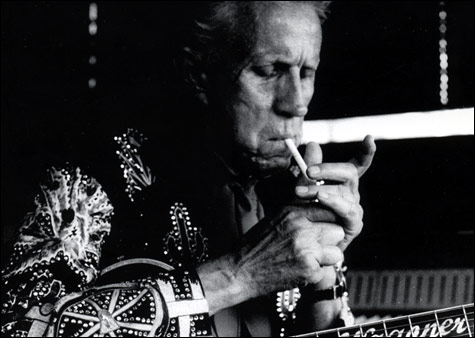
GOTH: Wagoner’s brilliant new CD on Epitaph’s Anti- label is a calculated end-run around the country-music industry.
|
NASHVILLE — “Eleven Cent Cotton” is a great country song, a wry, catchy, energetic, swinging two-step that creates a tableau of the bygone rural South while bearing a relevant message about America’s working impoverished in its chorus hook: “Eleven-cent cotton and forty-cent meat/How in the world can a poor man eat?” But fans of the genre are unlikely to hear it on mainstream radio, because the country music industry wrote off its author, Porter Wagoner, some two decades ago.
“When I encounter those people” — the executives who run the big-time country music mill — “they usually say, ‘Oh, are you still around?’,” the 79-year-old giant of the genre remarks, chuckling a little and shaking his head.
But Wagoner is now serving notice to the music business that he’s not only present, but remains capable of making what’s likely to be the best country album of 2007. That would be Wagonmaster, his first secular album in seven years, on the Epitaph imprint Anti-. And it’s flat-out brilliant. It’s also a calculated end-run around the country music business, masterminded by producer/multi-instrumentalist Marty Stuart.
Stuart, like many musicians, was inspired by Wagoner’s syndicated TV show, which at the peak of its popularity in the 1960s had more than 3.5 million viewers. So Wagonmaster plays like that program, which introduced Dolly Parton and many other emerging stars. The CD starts with the title track, Wagoner’s theme song, and works through all of his specialties — stories about unbearable human anguish, double-edged joy, spiritual questing, upbeat instrumentals, and the kind of gospel recitations he learned from apprenticing with country legend Red Foley and listening carefully to the tent revival preachers who barnstormed through his hometown of West Plains, Missouri, nestled in the Ozarks near the Arkansas border.
So far, the video for “Committed to Parkview” — where a lean, spangle-suited Wagoner serves as narrator for a tour through a mental institution as stark as Old London’s Bedlam — has been getting the most attention. The song was written by Johnny Cash and inspired by both Cash’s and Wagoner’s time at the Nashville hospital (Wagoner briefly stayed at Parkview in 1965 to recover from exhaustion). Although the Cash factor is a magnet, the album’s best songs are Wagoner’s own, such as “Be a Little Quieter,” about a lost lover whose presence haunts the singer, the jaunty “Eleven Cent Cotton,” and the painfully yearning “The Agony of Waiting,” where weeping pedal steel and moaning fiddle — longtime trademarks of Wagoner’s best honky-tonkers — play ghostly harmony to his time-weathered-but-still-resonant singing. As Wagoner admits, his voice was never pretty, but his plain delivery over a lightly swinging beat made his one of the most believable and recognizable sounds of country.
Considering Wagonmaster’s often-dark themes and Wagoner’s talent for telling stories frequently described as Southern Gothic, Stuart wisely placed the recording with the indie Anti- label, home to Tom Waits, among other notables. The goal is to take Wagoner to a new audience — the same roots-conscious listeners who appreciate Waits and Nick Cave, artists whose tales have a similar bent. And Anti- has done crossover miracle work recently with soul icons Solomon Burke and Bettye LaVette, two artists who’d been similarly spurned by the biz.
“At first I didn’t believe Marty when he told me we’d reach a lot of younger people with this album,” Wagoner said when we spoke at his comfortable, modest home on the Wagoner Ranch, a tract close to the Grand Ole Opry where he and much of his family reside. Instead of wearing one of the rhinestone-studded Nudie or Manuel suits he helped make famous on stage, Wagoner’s off-duty duds were decidedly unflashy blue jeans, white sneakers, a baseball cap, and a brown shirt with snap buttons. “But when I took my granddaughter, who’s 20, out to California with me to meet with the label, they were all so young and interested in my music, and they got along with her so well, I’m just as excited about Anti- as I was when I signed with RCA.”
That was in 1952, two years after he quit his job at Vaughan’s Butcher Shop in West Plains. After a few missteps, the hits started to arrive: “Company’s Coming,” “A Satisfied Mind,” “Cold Hard Facts of Life,” “Carroll County Accident,” “Skid Row Joe,” “Misery Loves Company,” “Don’t Let Me Cross Over,” “Green Green Grass of Home,” “I’ve Enjoyed About As Much of This As I Can Stand,” “Just Someone I Use to Know,” “The Last Thing on My Mind,” and dozens more.
“I think one thing that made me stand out from the Nashville sound in those days is that I brought my own sound, my own rhythm, with me,” Wagoner says. “You can have great words and a good melody, but without a good rhythm, you won’t have a hit.” In 1957 Wagoner joined the Grand Ole Opry, where he still plays four shows every weekend and just celebrated his 50th anniversary as a member (see sidebar).
“I’m still excited about being on that stage,” Wagoner says. “When I hear the applause, it makes me so happy to be appreciated for what I’m doing after all these years. I do think a lot about the people who were there when I joined, who I really miss and have passed on, like Roy Acuff, Cousin Minnie Pearl, and Ernest Tubb. The people who see the show like the new stars, too, but I think they enjoy coming to the Opry to be part of the history, and they see some of that in me.”